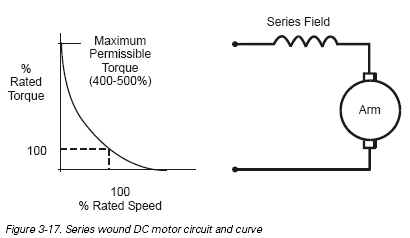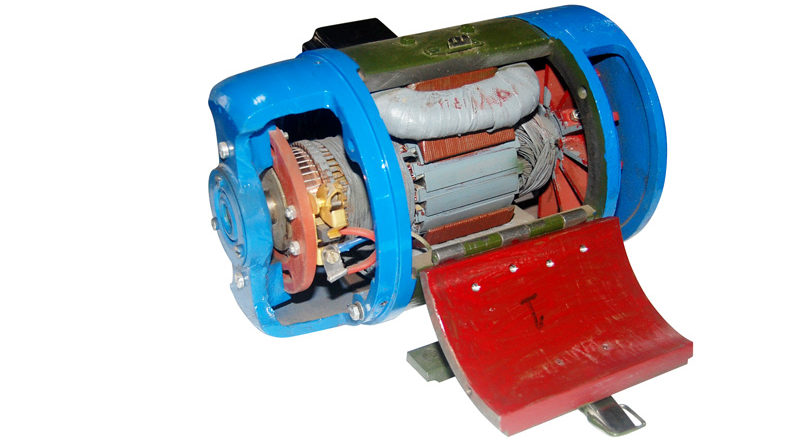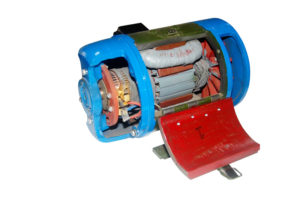DC Motor Working Types and Application
DC Motor working types and application are studying In this article we will also learn about the working of dc motor. We will know that what is the basic working of dc motor and also learn about the type of dc motor and application of dc motor.
DC Motor Working Types and Application
DC Motor Working
AS we know that an electric machines deals with the energy transfer either from mechanical to electrical from or from electrical to mechanical from, this process is called electro mechanical energy conversion. The working principle of dc motor is also same.
A electric motor is a device which convert or change an electrical energy into the mechanical energy .
It conversion system is totally opposite from dc generator. In dc generator, Mechanical power converts into electrical power. In a generator the input mechanical energy is supplied by a prime mover as like engine, while in a dc motor, input energy is supplied by a dc source as like battery. The construction of a dc machine is same, whether it is a generator or motor. In both type electrical machine construction is similar.
DC Motor Working Types And Application
The dc motor is based on the principle that when a current-carrying conductor or coil is placed in a magnetic field, it experiences a mechanical force whose direction id given by Fleming’s left-hand rule and whose magnitude is given by
F = B* I* L
Where
F , shows mechanical force which is developed in motor
B, is the magnetic field in weber, /meter square
L, is the length of the coil in meter.
The electric motor converts electrical power into mechanical power. We can simple say that it converts motion by using of electromagnetic induction. Dc machine can be used interchangeably as generator or as a motor. Because the working of motor and generator is similar, but some difference. These are dc motor working types and application.
General working of dc motor
Dc motors are various types some are, shunt –wound, compound wound, series –wound.
When the field magnets of the motor are excited and it is armature conductors or coil is supplied with current from the supply mains, then they experience a force tending to rotate the armature. Armature conductors under north (N)-pole are assumed to carry current down words (cross ) and under those south (S)-poles to carry current upwards (dots ). By use of Fleming’s left hand rule, the direction of the force on each conductor or coil can be found. The forces collectively produce a driving torque which keeps the armature rotating. Here this should be noted that function of commutator in the motor is the same in a generator. It is also main dc motor working type and application.
Effect of Back EMF in dc motor
For Knowing about the DC motor working, types and application it is must need to know about the Effect of back EMF in DC motor
In the dc motor as the armature rotates, the armature conductor cut the magnetic field and there by induce a EMF or voltage, electromagnetic force in these coil. Since this induce voltage opposes the applied terminal voltage, it is called the back e.m.f or counter EMF. This back EMF depends of the main factors as generated EMF in the generator. The speed and direction of rotation and the field strength, If the field is stronger and the speed is faster, then the back EMF will be larger. But the back EMF will always be less that the applied voltage because of the internal voltage drop caused by the resistance of the armature coils.
When the motor loaded, the phase of the voltage becomes closer to that of the current and the apparent resistance gives a voltage. So the back EMF or counter EMF required is smaller and the motor turns more slowly.
Back EMF = V – Armature current x Armature resistance
Where V is supplied voltage
When the armature start rotating, induced EMF is produced in the armature conductors, Fleming’s right hand rule give the direction of this induce EMF. The direction of induce EMF is directly opposite to the applied voltage. There for it is known as back EMF. Electric work is done in overcoming this opposition, which is converted into mechanical energy developed in the armature.
DC motor Types
Some different type of dc motors is currently in use. Like generators, there are mainly two types of dc motors characterized by the connections of field winding in relation to the armature viz. This is also provide help to understand the tiltle which is dc motor wokring type and application.
It is divided in two parts
1. Self-excited DC motor
2. Separately excited DC motor
1. Self-excited DC motor
In self-excited dc motor, the field winding is excited by the same source of supply. These types of motors can be further classified as shunt, series and compound. Compound motors can be further classified as differential and cumulative. Differential and cumulative motors can be further classified as long shunt. In summary,
2. Separately Excited Dc motor
Separately excited dc motor is also one in which filed excited by a separate source of supply. These are utilized in feedback control systems where control of the armature voltage over a wide range is required.
Types of Self-Excited Motor
Self-excited motor is dividing in two parts. It is self-excited motor which means in this type motor does not require any external source to operate motor. The resuldigm magnetism is connecting with the motor and provides starting flux to motor winding.
1. DC shunt motor
In this type motor, the field winding is connected in parallel with the armature. The current through the shunt field winding is not the same as that of the armature current. Shunt field wingd are designed to produce the necessary EMF using the relatively large number of turns of wire having high resistance. Therefore, shunt field current is relatively small as compared to the armature current.
The total line current is the sum of field current and armature current. These types of motor are ideal for applications requiring constant speed with changing load.
In shunt motor speed is become always constant; we can simply say that it provided constant speed.
Supply Voltage = Back EMF + Armature current * Armature resistance
2. DC series motor

These types of motors are ideal for applications requiring a high starting torque, high accelerating torque and /or high speeds with lighter loads.
3. DC Compound motor
These types of motors have two field wingdings, one connected in parallel with the armature and the other in series with it. There are two types of compound motors connections like generators. When the shunt filed winding is called short-shunt connection. When the shunt winding is so connected that it shunts the series combination of armature and series field.
The compound machines (motors or generators ) are always designed, so that the flux produced by shunt field winding is considerably larger than the flux produced by the series field winding. Therefore , shunt field in compound machines is the basic dominant factor in the production of the magnetic field in the machine. These types of motors are ideal sudden changes in load it maintains a reasonably constant speed. It main DC motor types which is use as both series and parallel.
DC motor Application
Motor are available in many sizes and types, but their basic functions are same motors of all types convert electrical power into mechanical power. They can be found in elevators, dvd players toys, watches, automobiles, buses, trains, ships air conditioner, refrigerators etc. so these are also defined the title which is dc motor working type and application.
DC motors are extensively used in variable-speed drives such as robotic drives, printers, in machine tools, process in rolling mill
In paper
Textile industries
They are also used in position-control systems where good dynamic response and steady state performance are required. However, for special applications such as steel mills, mines and electric trains, metro trains. It is advantageous to convert alternating current into direct current in order to use dc motors. According to post title the working principle of dc motor we describe dc motor on basic principle. The main advantage of dc motor, the speed characteristics of dc motors are much more superior to that of ac motors, In maximum cases, separately excited type of motor are used because of the combination of commutator within the motor . these are main DC motor application.
Hence it is the DC Motor Working Types and Application. if you will find any incorrect in this article please comment in below.
For Knowing more about DC Motor working Types and Application you must watch this video.


